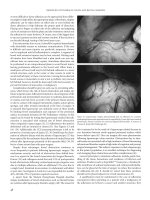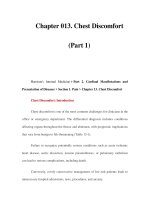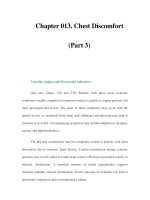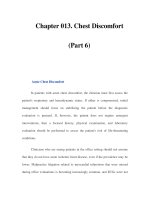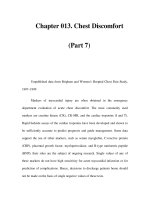Chapter 013. Chest Discomfort (Part 7) pps
Bạn đang xem bản rút gọn của tài liệu. Xem và tải ngay bản đầy đủ của tài liệu tại đây (17.81 KB, 8 trang )
Chapter 013. Chest Discomfort
(Part 7)
Unpublished data from Brigham and Women's Hospital Chest Pain Study,
1997–1999
Markers of myocardial injury are often obtained in the emergency
department evaluation of acute chest discomfort. The most commonly used
markers are creatine kinase (CK), CK-MB, and the cardiac troponins (I and T).
Rapid bedside assays of the cardiac troponins have been developed and shown to
be sufficiently accurate to predict prognosis and guide management. Some data
support the use of other markers, such as serum myoglobin, C-reactive protein
(CRP), placental growth factor, myeloperoxidase, and B-type natriuretic peptide
(BNP); their roles are the subject of ongoing research. Single values of any of
these markers do not have high sensitivity for acute myocardial infarction or for
prediction of complications. Hence, decisions to discharge patients home should
not be made on the basis of single negative values of these tests.
Provocative tests for coronary artery disease are not appropriate for patients
with ongoing chest pain. In such patients, rest myocardial perfusion scans can be
considered; a normal scan reduces the likelihood of coronary artery disease and
can help avoid admission of low-risk patients to the hospital. Promising early
results suggest that 64-slice CT and cardiac MRI may be of sufficient accuracy for
diagnosis of coronary disease that these technologies may become widely used for
patients with acute chest pain in whom the diagnosis is not clear.
Clinicians frequently employ therapeutic trials with sublingual
nitroglycerin or antacids or, in the stable patient seen in the office setting, a proton
pump inhibitor. A common error is to assume that a response to any of these
interventions clarifies the diagnosis. While such information is often helpful, the
patient's response may be due to the placebo effect. Hence, myocardial ischemia
should never be considered excluded solely because of a response to antacid
therapy. Similarly, failure of nitroglycerin to relieve pain does not exclude the
diagnosis of coronary disease.
If the patient's history or examination is consistent with aortic dissection,
imaging studies to evaluate the aorta must be pursued promptly because of the
high risk of catastrophic complications with this condition. Appropriate tests
include a chest CT scan with contrast, MRI, or transesophageal echocardiography.
Acute pulmonary embolism should be considered in patients with
respiratory symptoms, pleuritic chest pain, hemoptysis, or a history of venous
thromboembolism or coagulation abnormalities. Initial tests usually include CT
angiography or a lung scan, which are sometimes combined with lower extremity
venous ultrasound or D-dimer testing.
If patients with acute chest discomfort show no evidence of life-threatening
conditions, the clinician should then focus on serious chronic conditions with the
potential to cause major complications, the most common of which is stable
angina. Early use of exercise electrocardiography, stress echocardiography, or
stress perfusion imaging for such patients, whether in the office or the emergency
department, is now an accepted management strategy for low-risk patients.
Exercise testing is not appropriate, however, for patients who (1) report pain that
is believed to be ischemic occurring at rest or (2) have electrocardiographic
changes not known to be old that are consistent with ischemia.
Patients with sustained chest discomfort who do not have evidence for life-
threatening conditions should be evaluated for evidence of conditions likely to
benefit from acute treatment (Table 13-3). Pericarditis may be suggested by the
history, physical examination, and ECG (Table 13-2). Clinicians should carefully
assess blood pressure patterns and consider echocardiography in such patients to
detect evidence of impending pericardial tamponade. Chest x-rays can be used to
evaluate the possibility of pulmonary disease.
Guidelines and Critical Pathways for Acute Chest Discomfort
Guidelines for the initial evaluation for patients with acute chest pain have
been developed by the American College of Cardiology, American Heart
Association, and other organizations. These guidelines recommend performance of
an ECG for virtually all patients with chest pain who do not have an obvious
noncardiac cause of their pain, and performance of a chest x-ray for patients with
signs or symptoms consistent with congestive heart failure, valvular heart disease,
pericardial disease, or aortic dissection or aneurysm.
The American College of Cardiology/American Heart Association
guidelines on exercise testing support its use in low-risk patients presenting to the
emergency department, as well as in selected intermediate-risk patients. However,
these guidelines emphasize that exercise tests should be performed only after
patients have been screened for high-risk features or other indicators for hospital
admission.
Many medical centers have adopted critical pathways and other forms of
guidelines to increase efficiency and to expedite the treatment of patients with
high-risk acute ischemic heart disease syndromes. These guidelines emphasize the
following strategies:
Rapid identification and treatment of patients for whom emergent
reperfusion therapy, either via percutaneous coronary interventions or
thrombolytic agents, is likely to lead to improved outcomes.
Triage to non-coronary care unit monitored facilities such as
intermediate-care units or chest pain units of patients with a low risk for
complications, such as patients without new ischemic changes on their ECGs and
without ongoing chest pain. Such patients can usually be safely observed in non-
coronary care unit settings, undergo early exercise testing, or be discharged home.
Risk stratification can be assisted through use of prospectively validated
multivariate algorithms that have been published for acute ischemic heart disease
and its complications.
Shortening lengths of stay in the coronary care unit and hospital.
Recommendations regarding the minimum length of stay in a monitored bed for a
patient who has no further symptoms have decreased in recent years to 12 h or less
if exercise testing or other risk stratification technologies are available.
Nonacute Chest Discomfort
The management of patients who do not require admission to the hospital
or who no longer require inpatient observation should seek to identify the cause of
the symptoms and the likelihood of major complications. Noninvasive tests for
coronary disease serve both to diagnose this condition and to identify patients with
high-risk forms of coronary disease who may benefit from revascularization.
Gastrointestinal causes of chest pain can be evaluated via endoscopy or radiology
studies, or with trials of medical therapy. Emotional and psychiatric conditions
warrant appropriate evaluation and treatment; randomized trial data indicate that
cognitive therapy and group interventions lead to decreases in symptoms for such
patients.
Further Readings
Brennan M-
L et al: Prognostic value of myeloperoxidase in patients with
chest pain. N Engl J Med 349:1595, 2003 [PMID: 14573731]
Gibbons RJ et al: A
CC/AHA 2002 guideline update for exercise testing. A
report of the American College of Cardiology/American Heart Association Task
Force on Practice Guidelines (Committee on Exercise Testing). Available at
Accessed on January 22, 2006
Gibson PB et al: Low event rate for stress-
only perfusion imaging in
patients evaluated for chest pain. J Am Coll Cardiol 39:999, 2002 [PMID:
11897442]
Heeschem C
et al: Prognostic value of placental growth factor in patients
with chest pain. JAMA 291:435, 2004
Kwong RY
et al: Detecting acute coronary syndrome in the emergency
department with cardiac magnetic resonance imaging. Circulation 197:531, 2003
Leber AW et al: Quantification of obstructive and nonobstructive coronary
lesions of 64-slice compute
d tomography. J Am Coll Cardiol 46:147, 2005
[PMID: 15992649]
Swap CJ, Nagurney JT: Value and limitations of chest pain history in the
evaluation of patients with suspected acute coronary syndromes. JAMA 294:2623,
2005 [PMID: 16304077]
Tong KL et al: M
yocardial contrast echocardiography versus Thrombolysis
in Myocardial Infarction score in patients presenting to the emergency department
with chest pain and a nondiagnostic electrocardiogram. J Am Coll Cardiol 46:928,
2005
Tsai TT et al: Acute aortic syndromes. Circulation 205:3802, 2005


